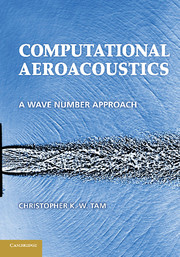Book contents
- Frontmatter
- Contents
- Preface
- 1 Finite Difference Equations
- 2 Spatial Discretization in Wave Number Space
- 3 Time Discretization
- 4 Finite Difference Scheme as Dispersive Waves
- 5 Finite Difference Solution of the Linearized Euler Equations
- 6 Radiation, Outflow, and Wall Boundary Conditions
- 7 The Short Wave Component of Finite Difference Schemes
- 8 Computation of Nonlinear Acoustic Waves
- 9 Advanced Numerical Boundary Treatments
- 10 Time-Domain Impedance Boundary Condition
- 11 Extrapolation and Interpolation
- 12 Multiscales Problems
- Chapter 13 Complex Geometry
- 14 Continuation of a Near-Field Acoustic Solution to the Far Field
- 15 Design of Computational Aeroacoustic Codes
- Appendix A Fourier and Laplace Transforms
- Appendix B The Method of Stationary Phase
- Appendix C The Method of Characteristics
- Appendix D Diffusion Equation
- Appendix E Accelerated Convergence to Steady State
- Appendix F Generation of Broadband Sound Waves with a Prescribed Spectrum by an Energy-Conserving Discretization Method
- Appendix G Sample Computer Programs
- References
- Index
4 - Finite Difference Scheme as Dispersive Waves
Published online by Cambridge University Press: 05 October 2012
- Frontmatter
- Contents
- Preface
- 1 Finite Difference Equations
- 2 Spatial Discretization in Wave Number Space
- 3 Time Discretization
- 4 Finite Difference Scheme as Dispersive Waves
- 5 Finite Difference Solution of the Linearized Euler Equations
- 6 Radiation, Outflow, and Wall Boundary Conditions
- 7 The Short Wave Component of Finite Difference Schemes
- 8 Computation of Nonlinear Acoustic Waves
- 9 Advanced Numerical Boundary Treatments
- 10 Time-Domain Impedance Boundary Condition
- 11 Extrapolation and Interpolation
- 12 Multiscales Problems
- Chapter 13 Complex Geometry
- 14 Continuation of a Near-Field Acoustic Solution to the Far Field
- 15 Design of Computational Aeroacoustic Codes
- Appendix A Fourier and Laplace Transforms
- Appendix B The Method of Stationary Phase
- Appendix C The Method of Characteristics
- Appendix D Diffusion Equation
- Appendix E Accelerated Convergence to Steady State
- Appendix F Generation of Broadband Sound Waves with a Prescribed Spectrum by an Energy-Conserving Discretization Method
- Appendix G Sample Computer Programs
- References
- Index
Summary
Acoustics are governed by the compressible Navier-Stokes equations. In most cases, molecular viscosity is unimportant, so that the use of Euler equations is sufficient. In solving the Navier-Stokes or Euler equations computationally, the first step is to perform a discretized approximation to the spatial and temporal derivatives. This converts the partial differential equations to a set of partial difference equations. However, one must recognize that the solutions of the discretized equations are not the same as those of the original partial differential equations. A central effort of computational aeroacoustics (CAA) is to understand mathematically the behavior of the solution of the discretized equations and to quantify and minimize the error. Here, error is referred to as the difference between the solution of the original partial differential equations and the partial difference system.
Invariably, finite difference approximation of the governing equations of acoustics will result in a dispersive wave system (Vichnevetsky and Bowles, 1982; Trefethen, 1982; Tam and Webb, 1993; Tam 1995), even though the waves supported by the original partial differential equations are nondispersive. This is an extremely important point and should be clearly understood by all CAA investigators and users.
- Type
- Chapter
- Information
- Computational AeroacousticsA Wave Number Approach, pp. 45 - 60Publisher: Cambridge University PressPrint publication year: 2012



